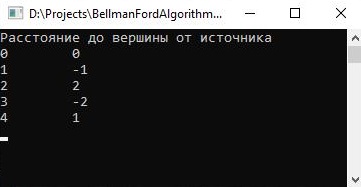В этом примере мы изучим реализацию на языке C# алгоритма Беллмана–Форда для определения кратчайших путей от одной исходной вершины до всех остальных вершин в взвешенном графе
using System;
using System.Collections.Generic;
using System.Linq;
using System.Text;
using System.Diagnostics;
namespace BellmanFordAlgorithm
{
class BellmanFordAlgo
{
public struct Edge
{
public int Source;
public int Destination;
public int Weight;
}
public struct Graph
{
public int VerticesCount;
public int EdgesCount;
public Edge[] edge;
}
public static Graph CreateGraph(int verticesCount, int edgesCount)
{
Graph graph = new Graph();
graph.VerticesCount = verticesCount;
graph.EdgesCount = edgesCount;
graph.edge = new Edge[graph.EdgesCount];
return graph;
}
private static void Print(int[] distance, int count)
{
Console.WriteLine("Расстояние до вершины от источника");
for (int i = 0; i < count; ++i)
Console.WriteLine("{0}\t {1}", i, distance[i]);
}
public static void BellmanFord(Graph graph, int source)
{
int verticesCount = graph.VerticesCount;
int edgesCount = graph.EdgesCount;
int[] distance = new int[verticesCount];
for (int i = 0; i < verticesCount; i++)
distance[i] = int.MaxValue;
distance[source] = 0;
for (int i = 1; i <= verticesCount - 1; ++i)
{
for (int j = 0; j < edgesCount; ++j)
{
int u = graph.edge[j].Source;
int v = graph.edge[j].Destination;
int weight = graph.edge[j].Weight;
if (distance[u] != int.MaxValue && distance[u] + weight < distance[v])
distance[v] = distance[u] + weight;
}
}
for (int i = 0; i < edgesCount; ++i)
{
int u = graph.edge[i].Source;
int v = graph.edge[i].Destination;
int weight = graph.edge[i].Weight;
if (distance[u] != int.MaxValue && distance[u] + weight < distance[v])
Console.WriteLine("Граф содержит цикл отрицательного веса.");
}
Print(distance, verticesCount);
}
static void Main(string[] args)
{
int verticesCount = 5;
int edgesCount = 8;
Graph graph = CreateGraph(verticesCount, edgesCount);
// Edge 0-1
graph.edge[0].Source = 0;
graph.edge[0].Destination = 1;
graph.edge[0].Weight = -1;
// Edge 0-2
graph.edge[1].Source = 0;
graph.edge[1].Destination = 2;
graph.edge[1].Weight = 4;
// Edge 1-2
graph.edge[2].Source = 1;
graph.edge[2].Destination = 2;
graph.edge[2].Weight = 3;
// Edge 1-3
graph.edge[3].Source = 1;
graph.edge[3].Destination = 3;
graph.edge[3].Weight = 2;
// Edge 1-4
graph.edge[4].Source = 1;
graph.edge[4].Destination = 4;
graph.edge[4].Weight = 2;
// Edge 3-2
graph.edge[5].Source = 3;
graph.edge[5].Destination = 2;
graph.edge[5].Weight = 5;
// Edge 3-1
graph.edge[6].Source = 3;
graph.edge[6].Destination = 1;
graph.edge[6].Weight = 1;
// Edge 4-3
graph.edge[7].Source = 4;
graph.edge[7].Destination = 3;
graph.edge[7].Weight = -3;
BellmanFord(graph, 0);
Console.ReadKey();
}
}
}

